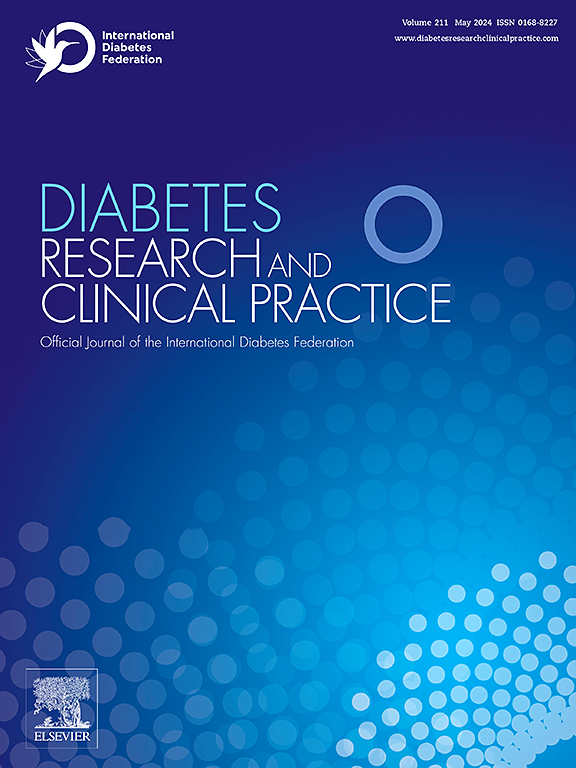基于早中期妊娠综合征筛查中类固醇激素变化的妊娠糖尿病预测模型:多中心纵向研究。
IF 6.1
3区 医学
Q1 ENDOCRINOLOGY & METABOLISM
引用次数: 0
摘要
背景:孕期类固醇激素(SH)与妊娠糖尿病(GDM)的发生有关。早期和中期唐氏综合征筛查用于评估胎儿患唐氏综合征的风险。目前还不清楚这一时期 SH 的变化是否可作为 GDM 的早期预测指标:本研究是一项多中心纵向队列研究。GDM 是在妊娠 24 至 28 周期间通过口服葡萄糖耐量试验 (OGTT) 诊断出来的。我们分别在唐氏综合征筛查早期和中期测量了SH水平。根据 SH 的变化,采用逻辑回归分析构建了 GDM 的预测模型。最后,通过创建接收者操作特征曲线(ROC)和进行外部验证来评估模型的预测性能:该研究共招募了 193 名孕妇(发现队列,157 人;验证队列,36 人)。怀孕后,SH 会发生动态变化。在早期唐氏综合征筛查中,只有皮质醇(F)(p 结论:GDM 预测模型可用于妊娠期糖尿病的预测:在早期和中期唐氏综合征筛查中,可利用 SH 测量值构建 GDM 预测模型。本文章由计算机程序翻译,如有差异,请以英文原文为准。
A prediction model for gestational diabetes mellitus based on steroid hormonal changes in early and mid-down syndrome screening: A multicenter longitudinal study
Background
Steroid hormones (SH) during pregnancy are associated with the development of gestational diabetes mellitus (GDM). Early and mid-Down syndrome screening is used to assess the risk of Down syndrome in the fetus. It is unclear whether changes in SH during this period can be used as an early predictor of GDM.
Methods
This study was a multicenter, longitudinal cohort study. GDM is diagnosed by an oral glucose tolerance test (OGTT) between 24 and 28 weeks of gestation. We measured SH levels at early and mid-Down syndrome screening, respectively. Based on the SH changes, logistic regression analysis was used to construct a prediction model for GDM. Finally, evaluated the model’s predictive performance by creating a receiver operating characteristic curve (ROC) and performing external validation.
Results
This study enrolled 193 pregnant women (discovery cohort, n = 157; validation cohort, n = 36). SH changes occur dynamically after pregnancy. At early Down syndrome screening, only cortisol (F) (p < 0.05, 95 % CI 4780.95–46083.68) was elevated in GDM. At mid-Down syndrome screening, free testosterone (FT) (p < 0.01, 95 % CI 0.10–0.55) and estradiol (E2) (p < 0.05, 95 % CI 203.55–1784.78) were also significantly elevated. There were significant differences in the rates of change in E2 (Fold change (FC) = 1.3425, p = 0.0072), albumin (ALB) (FC=1.5759, p = 0.0117), and dihydrotestosterone (DHT) (FC=-2.1234, p = 0.0165) between GDM and no-GDM. Stepwise logistic regression analysis resulted in the best predictive model, including six variables (Δweight, ΔF, Δcortisone (E), ΔE2, Δprogesterone (P), ΔDHT). The area under the curve for this model was 0.791, and for the external validation cohort, it was 0.799.
Conclusions
A GDM prediction model can be constructed using SH measures during early and mid-Down syndrome screening.
求助全文
通过发布文献求助,成功后即可免费获取论文全文。
去求助
来源期刊

Diabetes research and clinical practice
医学-内分泌学与代谢
CiteScore
10.30
自引率
3.90%
发文量
862
审稿时长
32 days
期刊介绍:
Diabetes Research and Clinical Practice is an international journal for health-care providers and clinically oriented researchers that publishes high-quality original research articles and expert reviews in diabetes and related areas. The role of the journal is to provide a venue for dissemination of knowledge and discussion of topics related to diabetes clinical research and patient care. Topics of focus include translational science, genetics, immunology, nutrition, psychosocial research, epidemiology, prevention, socio-economic research, complications, new treatments, technologies and therapy.
 求助内容:
求助内容: 应助结果提醒方式:
应助结果提醒方式:


